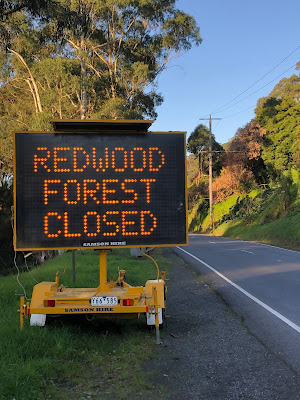 | ||||
A Welcome to Warburton sign on the outskirts of town it is not. For more than one reason. Firstly, the forest is a big drawcard, one of the chief reasons I’m here. Secondly, the words ‘forest’ and ‘closed’ in the same sentence? I’m sorry, they simply don’t belong together. Myer closes, so do servos, sometimes. Forests don’t! Or shouldn’t. I’m not going for a coffee or a three-pack of new socks. I’m here to hike, in nature.
I’ve escaped the city for a week’s R & R. I can already feel my muscles soften. The ground is a carpet of red, gold and orange autumn leaves. The green contours of the land evoke the topography of the Northern Rivers, the earthy smell of decay a familiar reminder. The babbling Yarra River, meandering, rewards my frayed senses, confers the gentle pause my body longs for.
But this forest closed business can’t be for real. When I check out Mrs Google, I see the bridge over the Yarra River leading to the forest is under reconstruction. It’s the only vehicular access to the forest. Wading through the river is an option, but I’d have to have my head read. I must find a way to the forest. The images of the towering redwoods on the web lend strength and immediacy to the lure in my bones. I recognise this urgent, bracing call, this unambiguous audacity I’m certain I’ve carried for lifetimes.
I’ve heard there’s a path high in the mountains. It’s an old maintenance track built to support an aqueduct that in 1911 was constructed to supply water to the greater City of Melbourne. Today it’s a hiking trail, a 32 km return trip that takes you close to the forest. I’ll pedal.
Mr Bike Man is patient, and not bad on the eye. Reciting the 5000-word Operation Manual and Book of Expected Behaviour for Novice E-Bike Riders, he stops occasionally to establish my comprehension; I nod, thinly. Inside, my anxiety reaches new heights. He then proceeds to show me the route on a very small map – gates to negotiate, steep slippery inclines that require me to walk the bike, crossings of main roads, forks on the path. I’ve absorbed about 10% of the whole delivery. I come within an eyelash of quitting.
The reward is the route. It traverses great stands of mountain ash and walls of tree ferns. Yellow-tailed black cockatoos wail and sweep across the path ahead of me. The glorious sun is out, and my wobbly arms are getting furiously itchy from the increased blood flow and vibration of a 22 kg bike doing around 12 km an hour on an uneven path. Within ten minutes, I’m a pro.
On first sight of the forest, the words of the exiled Vietnamese master, Thich Nhat Hanh, sound in my head; ‘I have arrived. I am home’. I am awe-struck; don’t know whether to walk, sit, or stand. I reach my hand to the forest floor; its spongy, yielding layer is damp. Around my feet a dozen different species of fungi sprout. I crouch and examine the bionetwork of colourful fungus. Some serious psilocybin going on here.
But it is the largesse of the scene before me that renders me dumb.
This enchantment and involuntary hijacking of my sensory field imbues a rush I’m unable to process. I close my gaping mouth, quieten the need to do something. Entering a forest of this scope is akin to crossing a threshold into a marginal place of otherness. Something transcendent happens. The usual direction of my thoughts to the inner field does a one-eighty. The pores of my skin unzip and open to the throb of the woodland as though they’ve set eyes on a dear old lost friend. I’ve been mourning my absence from the forest, and the strange thing is, I’ve barely even noticed it happen. I gaze up, and see, not for the first time, the evidence of what Jane Hirshfield, poet and Zen practitioner refers to as ‘blind optimism’. Here she is referring to the ability of trees to sightlessly trust the primal gravitational pull of the species to orient to the light. It is the original act of fidelity to life itself. The interdependence of the ecosystem here is so obvious and breathtaking, a symbiotic smorgasbord of co-operation and growth. I am undone.
Every so often, an artist by the name of David Digapony, spends a day in the forest, collects the fallen branches that project vertically off the trunk of the Redwood, and sculpts the timber into forms of beauty. These forms are scattered throughout the forest.
Fourteen hundred Redwoods (Sequoia sempervirens) occupy this plantation, a non-native species of the cypress family originating in California. Sequoia sempervirens is among the tallest, widest, and oldest living trees on the planet. With enough water and nutrients this species is known to live for 3000 years. In the drought-ridden climate conditions of today, these statistics no longer apply. The trees now form part of the Yarra Ranges National Park, and are a major tourist attraction. How lucky am I to have had the park to myself?
Unruly, black sheep Sequoia by the river in the township
I want to be more like a tree. To trust in seasons of change, move to the rhythms of the cycles of life, urge my frail human heart to have faith in the shifting landscape of time.












Fabulous Catherine, beautifully captured and related, sensational pics too! Thanks for sharing the experience.
ReplyDelete